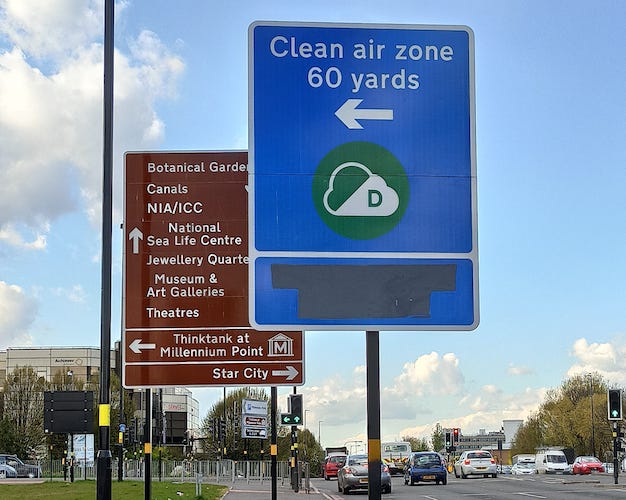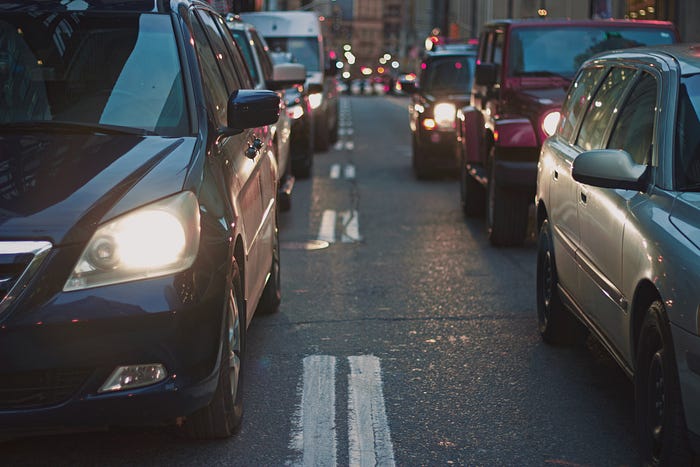William Bloss: “Ideally, to improve our health, we need to be tackling levels of NO2 which the Clean Air Zone is doing.”

The Clean Air Zone (CAZ) is mere hours to be launched in Birmingham and it aims to reduce the air pollution inside the Middleway ring road. Which is caused by older vehicles. But this is only one side of the air pollution discussion, driven by NO2. The other one is fine particles, sometimes shortened to PM.
“There’s two main air pollutants that we focus on in Birmingham at the moment. One is the NO2 gas from diesel vehicles. And the second is fine particles that PM in the air suspended little bits of solid and liquid”, said William Bloss. He’s a professor at the University of Birmingham (UoB) and he also leads the WM-Air project, which is an initiative that aims to give support to improve air quality in the West Midlands.
Bloss said that PM2.5 are the ones that are small enough to inhale into our lungs. And the main source of it comes from burning things, such as wood and coal.
“But vehicles are not the overwhelming source of PM, in the same way as vehicles are the overwhelming source of NO2. So ideally, to improve our health, we need to be tackling levels of NO2 which the Clean Air Zone is doing for that area of the city. But a lot of people live outside the Clean Air Zone area. And we need to be tackling the levels of PM across the city as well.
“The Clean Air Zone is all about nitrogen dioxide, or NO2, which in Birmingham comes overwhelmingly from road vehicles. And particularly older vehicles, older diesels within that. So the Clean Air Zone is arising because the air quality fails the UK legal limits for NO2.”

Possible risks from the CAZ
When asked about the risks of the CAZ pushing the pollution outside that zone, Bloss said: “We might expect the effect will be to reduce the number of journeys carried out by those older vehicles within the ring road. But potentially to displace some of those to outside.”
At the moment, it’s too early to tell if that will be the case here. An example that can be looked upon is London as William Bloss said: “There are reductions in journeys, and that people do take personal actions themselves in terms of changing how they travel or changing vehicle type, maybe a subset of population that’s in a financial position to do that”
What happens next, after the launch of the Clean Air Zone
Once the Clean Air Zone is launched, and a charge to the more pollutant cars is in place, what will be the next step to take both inside the zone and outside of it? Firstly, there’s the need to consider that some drivers will have a one-year exemption and might have to change their vehicle or the way they travel.
Bloss said: “There’s a need to have appropriate support for people who will be particularly affected by the Clean Air Zone. And you know, there may be families and maybe small businesses, who are not in a position to go out and change their vehicle or to relocate where they drive”.

Earlier in the month, Birmingham City Council opened a £10m scheme that aims to give support to workers in the CAZ, who in exchange from scrapping a vehicle will receive a £2,000 grant that can be either used as a “travel credit” or to purchase a vehicle that respects the emission levels needed.
“It has to be part of a concerted policy to change the way we move around, whether that’s reducing journeys, whether that’s active travel, or whether it’s using cleaner vehicles, ultimately, electric vehicles from the air quality point of view, that have much lower tailpipe emissions on the roads”
PM 2.5 and NO2, more than letters and numbers
With the Clean Air Zone already in motion, the discussion of air pollution is being directed to the cars but it’s not the only one we need to focus on:
“There’s two main air pollutants that we focus on in Birmingham at the moment. One is the NO2 gas from diesel vehicles. And the second is fine particles that PM in the air suspended little bits of solid and liquid. And we often talk about PM 2.5, which are the ones that are small enough to inhale into our lungs. So the main source of PM 2.5 is burning things essentially” said Bloss.
“But vehicles are not the overwhelming source of PM, in the same way as vehicles are the overwhelming source of NO2. So ideally, to improve our health, we need to be tackling levels of NO2 which the Clean Air Zone is doing for that area of the city. But a lot of people live outside the Clean Air zone area. And we need to be tackling the levels of pm across the city as well.”

What can we learn from cities like Beijing or Delhi
One of the projects he overlooks at the UoB is about the air quality in more pollutant cities like Beijing and Delhi. In China there has been an improvement in the past few years, and that was due by a clear political action, such as removing “Some of the most polluting industries from the city centre in Beijing and to clean up factory emissions” and added: “It’s giving us confidence that we do understand what’s happening and that if we take sufficiently courageous actions, we can see the effect”.
Last year’s measures taken by governments all around the globe, to tackle the pandemic had people stay at home, which reduced drastically the traffic and levels of pollution. Bloss said:
“That’s given us confidence in the science is how the air changed during the COVID lockdowns” and added:
“So in March-April 2020, when traffic levels were reduced dramatically, more or less overnight, we also saw the NO2 levels fall very significantly and that sort of gives us confidence that we understand the processes that are going on.”
Delft and the 15-minute neighbourhood concept
And in matters of examples to follow that could help Birmingham bring down its levels of NO2 down, Bloss mentioned the Netherlands and in particular the city of Delft:
“[It] is held up as one example of the 15-minute neighbourhood concept, the idea of trying to design cities such that many journeys can be within a walkable or cyclable distance of essentially, many people in the population.”
Closer to Birmingham, he also mentioned London’s case and its low emission zone that reduced the levels of nitrogen dioxide by 30%. While for particulate matter, Bloss said:
“The key measure is to reduce what we burn in our homes. So, to try and avoid burning solid fuels or definitely avoid burning wet fuels or wet wood people who burn wood for heating or relaxation at home. And similarly to think about how we heat and power our businesses, our industries and so on. And where we can, to replace that ideally with a renewable energy source driven from electricity or a cleaner source of heating, like gas.”

How to connect COP26 with the problem of air pollution
And with COP26 coming in November, I asked him if there was a possibility to have the discussion of air pollution in the debate, even if the event is centred around climate change and CO2, of which he said: “Lasts a long time in the air and the environment it spreads around the planet”. While CO2 is a problem than needs a global response, NO2 can be brought down to a more local level. Despite those differences, William Bloss said:
“There are lots of win-wins between the climate and the air quality policy. But I think it’s quite useful for people and policy makers to understand that the air quality side of that delivers local environmental benefits and local health benefits” and added: “I think that’s a subtlety of the discussion that gets lost, which is quite useful in trying to motivate people to change how they’re behaving.”
If you want to know more about the Clean Air Zone, you can read this explainer centred on Birmingham, or the interview I did to Andrea Lee from ClientEarth.